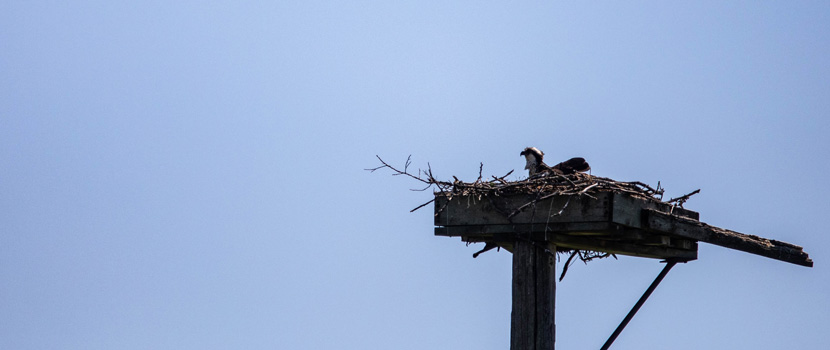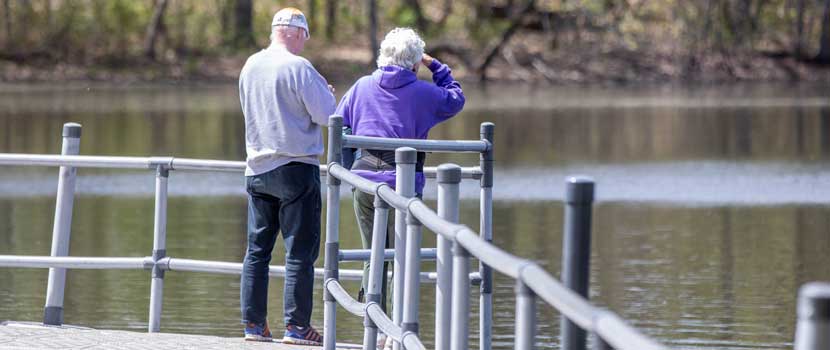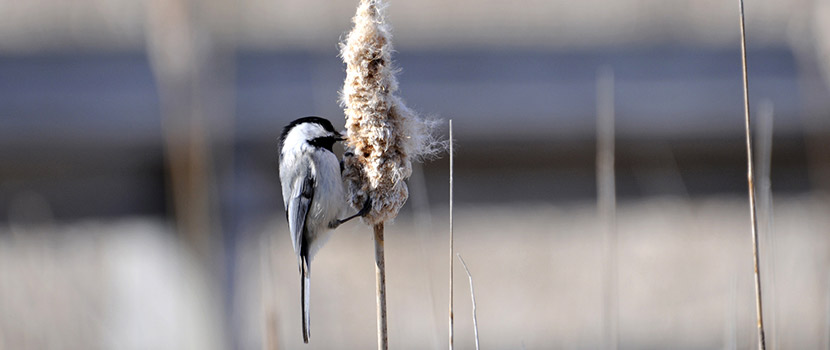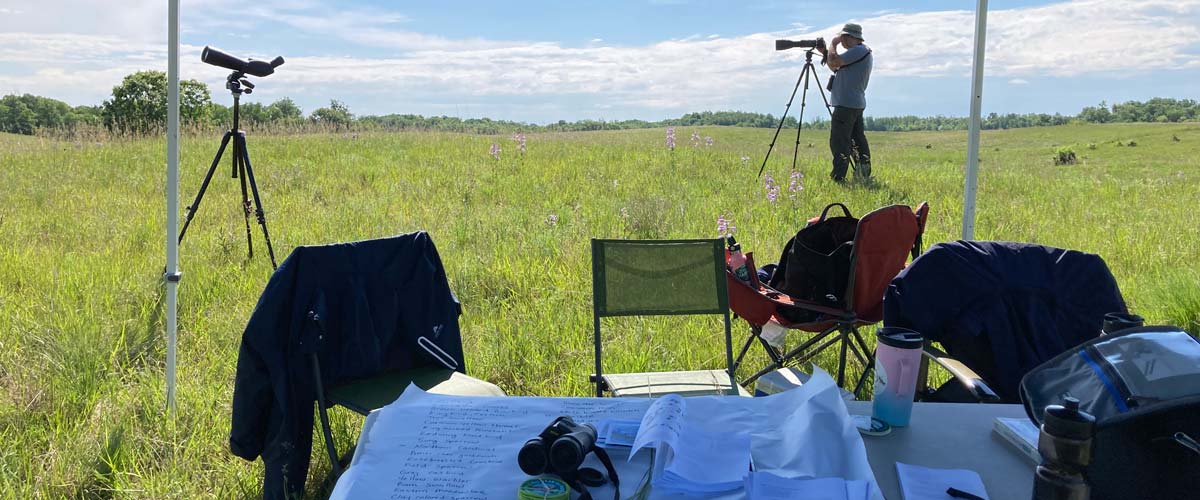
In Review: Our Big Year of Birds in Numbers
By: Sam Safran & Steven Hogg & John Moriarty
May 23, 2023
Category: Big Year of Birds
In 2022, the Three Rivers Park District celebrated a Big Year of Birds! You learned more about these amazing creatures by joining us at programs and special events, listening to podcasts, reading our blog, and participating in special birding days where we counted different species within Three Rivers parks.
Throughout the year, we asked you to log your bird sightings in the online tool called eBird. We dove into the data to pull out some of the highlights of an amazing year celebrating birds in the parks. How many species were found? Who documented the most species? How did the year compare to past years? Read on to find out!
This blog post uses data from eBird to summarize user-submitted birding activity within the Park District. EBird is a popular platform maintained by the Cornell Lab of Ornithology for people to document their bird observations. While these data paint a rich picture, many people enjoy birds in the parks without using eBird, so the numbers presented here surely undercount the true scope of birding activity in the parks
Would you like to dive into the data? Explore even more Three Rivers birding statistics.
Getting out to bird
In 2022, 747 different people used eBird in Three Rivers parks, the largest number of any year on record! We’re especially happy 294 of these observers were new to the parks in 2022 (at least on eBird).
Together, eBirders submitted a total of 4,500 “checklists” documenting the birds they saw on visits to Three Rivers parks. Checklists are lists of which birds a person was able to see and hear on a birding outing. When submitting a checklist, one key piece of information a user includes is how far the they traveled while searching for birds. Adding up all of the individual distances, eBirders traveled a total of nearly 7,000 miles in the parks. That’s the equivalent of driving from Minneapolis to Duluth and back more than 22 times. Or doing one big loop of the continental United States:
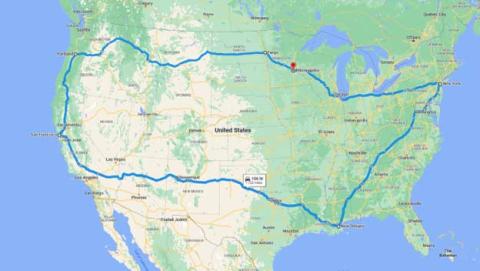
Checklists also record how long people spent searching for birds during their outing. The 5,800 hours logged by eBirders in the parks in 2022 matches the effort of nearly three hypothetical people surveying birds full-time and year-round (assuming eight-hour workdays, five days a week). This contribution of time helps park managers to know which species are using the park and how abundant they are, which is invaluable for monitoring the health of wildlife in the parks! Data collected by eBirders helps to supplement the formal surveys of birds conducted by park biologists and volunteers.
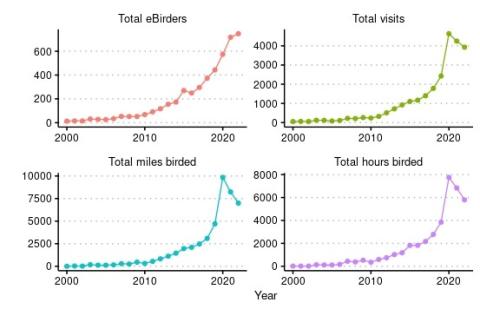
Special birding days
Birding effort was not consistent year-round. Visits to the parks by eBirders peaked in May, which coincides with the peak of the birds north-bound spring migration (and warmer weather!).
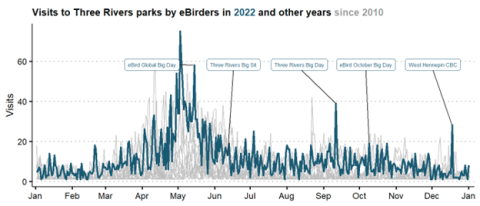
A few special days on the calendar boosted birding activity in the parks. The eBird Global Big Day, celebrating World Migratory Bird Day, on May 14, was the year’s second-busiest day for birding. (The busiest day was May 2, when many birders flocked to Hyland Lake Park Reserve to see a group of rare black-bellied whistling ducks and a rare yellow-crowned night heron). The Three Rivers Parks Big Sit on June 11 invited participants to see how many birds they could see from one spot over the course of a day. It wasn’t an eBird-focused event, so did not result in a notable boost in the number of submitted checklists, but staff counted 190 visitors at stations in seven different parks who documented a total of 81 species!
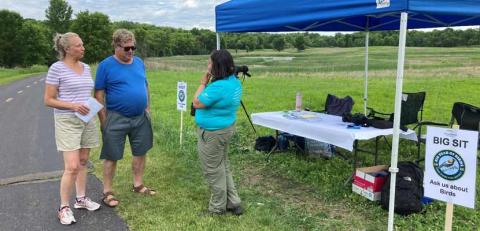
Other notable days include the inaugural Three Rivers Parks Big Day on September 10, in which 11 teams engaged in friendly competition to observe as many species in Three Rivers Parks as possible. Together the teams documented a total of 102 species! A team with Three Rivers natural resources staff (“The Ins’eiders’”) set a high bar with 80 species, but the winning “civilian” team was not far behind, observing a total of 66 species! Congratulations to team “Craig’s Fans”: Kevin O'Connor, Val Landwehr, Kat Baumtrog and Paul Baumtrog!
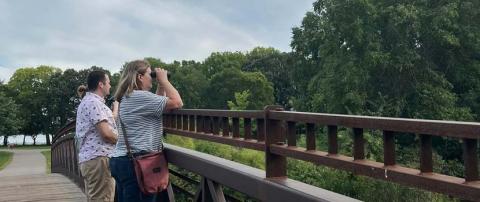
Another great day of birding in the parks was the inaugural West Hennepin Christmas Bird Count on December 17, part of a larger effort organized by the National Audubon Society. The new count organized by Three Rivers staff covers Crow-Hassan, Baker and Lake Rebecca park reserves, as well as surrounding parts of Hennepin and Wright counties. Birding visits to the parks surged on the day to 10 times their average for this time of year. In addition to getting people outside in the winter, the day was successful in generating data that can help us to understand the long-term effects of land use and climate change on the distribution of wintering birds across the parks, state and country. (For an example of the importance of community science, check out this article, describing a recent Audubon Society study that used 90 years of data from the Christmas Bird Count).
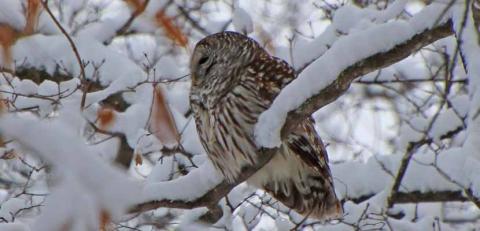
Individual birding achievements
Congratulations to Kevin O'Connor, who observed a total of 194 species in the parks in 2022, the most of any eBirder in the Three Rivers parks! Kevin observed more than 80% of all the species observed in the parks last year. Over the course of 109 visits to 10 different parks, Kevin logged a total of more than 200 hours eBirding and traveled more than 330 miles within the parks doing so.
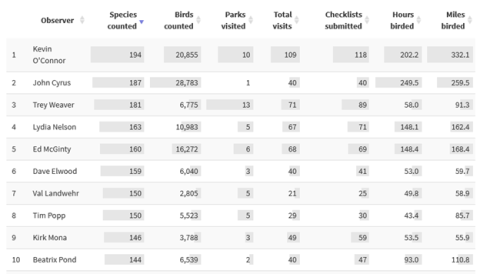
Second place for species count goes to John Cyrus, whose birding in Three Rivers Parks focused heavily on a single park: Carver Park Reserve. John logged visits to the park 40 times in 2022, documenting 187 species. On May 15 alone, John observed an amazing 23 different species of warblers! The whopping 28,783 individual birds logged by John in 2022 was the most of any eBirder in the park system.
The most species observed on a single day in the parks was 115 species at Murphy-Hanrehan Park Reserve by Liz Harper on May 15 (checklists here and here).
The “park hopper” award goes to Trey Weaver, who recorded birds in 13 different parks!
A look at the birds
In 2022, birders identified a grand total of 240 species of birds in the parks! This was the second-highest species count for the parks ever logged on eBird and includes more than 80% of the species that have ever been documented in the parks (most of the “missed” species are rare birds that do not regularly occur in the parks). The diversity of birds in the parks ranged from tiny (ruby-throated hummingbird: 732 observations) to tall (sandhill crane: 1,544 observations). From colorful (scarlet tanager: 732 observations) to drab (clay-colored sparrow: 930 observations). From common (Canada goose: 25,108 observations) to rare (northern goshawk: 1 observation).
Conservation
The parks are critical habitat for many species in need of conservation. Sixty-seven of the 92 bird species on the Minnesota Department of Natural Resource’s Species of Greatest Conservation Need list were documented in the parks in 2022. This includes six species in which the Minnesota population of the species represents a significant portion of the total North American population: American white pelican, bobolink, golden-winged warbler, sedge wren, trumpeter swan and veery. Continuing to provide habitat for these and other species in the parks is important to support larger efforts aimed at their conservation and recovery.
Flocks of birds
One of the joys of birding is witnessing the spectacle of large groups of birds. On November 1, Liren Varghese counted 2,500 American coot at French Regional Park, the largest count of a single species on any checklist in 2022. Other exciting high counts include the 500 tree swallows documented by Michael Hurben at Hyland Lake Park Reserve on May 3, 164 Lapland longspurs by Devon N. and Alex Sundvall at Crow-Hassan Park Reserve on March 16, and 109 American redstarts by John Cyrus at Carver Park Reserve on May 16. (What’s the largest count of a single species ever in the park district on eBird? On November 3, 2017, John Cyrus counted 4,200 red-winged blackbirds at Carver Park Reserve!)
Familiar feathers
There are some kinds of birds that feel like good friends because we encounter them so frequently. In Three Rivers parks the most familiar of all is perhaps the black-capped chickadee, which was seen by more people (601 different eBirders), in more parks (25) and on more days (346) than any other species.
New birds
There were two species of birds that were documented on eBird in the parks for the first time in 2022. On April 24, Liren Varghese observed and photographed a migrating cattle egret at Crow-Hassan Park Reserve before it was chased off by American crows.
On May 3, while birders were flocking to Hyland Lake Park Reserve to see a rare yellow-crowned night-heron, Joey Reichoff found the park district’s first Say’s phoebe, a vagrant species usually found further west.
Missing species
A few species were conspicuously absent from the parks in 2022. While regularly observed in the past, western meadowlark has not been documented since 2020. Migrating snow geese are usually documented a few times a year in the parks, but not in 2022. Other occasional migrants in the parks not documented last year include semipalmated sandpiper, golden eagle and Nelson’s sparrow. Keep your eyes and ears open for these species next year!
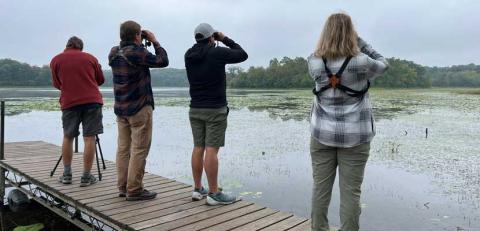
Closing thoughts
It is interesting to note that a few metrics of birding activity in the parks (total visits, total miles traveled birding and total hours birded) continued to decline from their all-time peak in 2020. We suspect this is related to changes in birding activity and outdoor recreation due to the COVID-19 pandemic. After a spike in outdoor recreation the first full year of the pandemic, the data suggest a partial return towards previous activity levels. Encouragingly, the total number of people using eBird in the parks has not declined since 2020, but instead has continued to grow (more people are using eBird in the parks, but less frequently on average).
We loved celebrating the Big Year of Birds with park visitors in 2022 and hope your energy and enthusiasm has continued into 2023. If this post has inspired you to learn more about eBird, you can find helpful resources here. As shown on this blog post, data submitted through the platform help to paint a rich picture of how the parks are used by birds and birders alike! The data are valuable no matter what your skill-level and the value of the dataset will only continue to grow over the years. We can’t wait to see what birds you find!
Banner photo courtesy of Angela Grill, from the Big Sit site at Crow-Hassan Park Reserve on June 11, 2022.
About the Authors
Sam Safran is a Ph.D. candidate at the University of Minnesota working with Three Rivers Park District to help assess how wildlife in the parks have responded to habitat restoration and management. His research involves developing new ways to use data from community-science projects (like eBird and iNaturalist) to study how species are responding to environmental change in cities and their surrounding areas. Sam loves birding, exploring streams and gardening with native plants in his backyard.
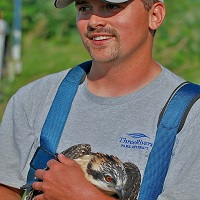
Steven Hogg is the Wildlife Supervisor at Three Rivers Park District and has been working for the Park District for 13 years. After graduating from the University of Alberta with a degree in Environmental and Conservation Biology, he moved to Minnesota to marry his beautiful Minnesota bride. Steven has always had a passion and dedication for wildlife, even when he was young. This passion is what lead him into a career where he strives for the proper orchestration of research, management, and politics to ensure natural resources and wildlife are given a voice. In his spare time, which there is little of with his three kids, Steven likes to farm, hunt, and fish.
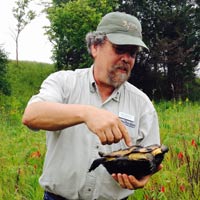
John Moriarty is the Senior Manager of Wildlife at Three Rivers Park District and has been with the Park District for 15 years. He has been involved in many of the wildlife restoration efforts and initiated the snake and butterfly efforts. John has led several projects to increase prairie habitat in the Park District. John likes exploring natural areas and looking for all types of plants and animals, but especially turtles.
Related Blog Posts
Birding Etiquette and How to Be an Ethical Birder
By: Three Rivers Staff
When you're birding, it's important to keep in mind how your presence can affect the creatures you're looking for. Learn basic guidelines that can help you respect the birds, their habitat and other people in the park.
How to Start Birding
By: Alan Holzer
Whether you're scanning trees from the trail or a feeder from your window, birding is a flexible outdoor activity that you can enjoy in any season. Read on to find out the basics of birding and what you need to get started.
2022: Three Rivers Parks’ Big Year of Birds
By: John Moriarty
We’re all about birds in 2022! Learn why Three Rivers is celebrating these important creatures throughout the year and how you can join in.
